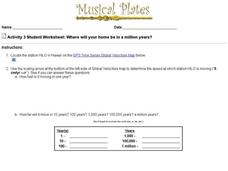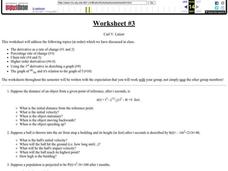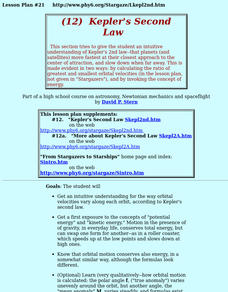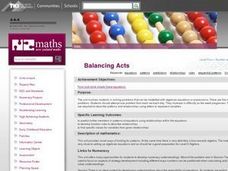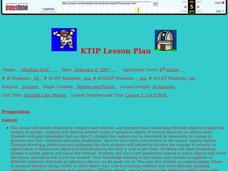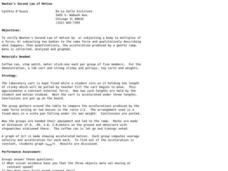Curated OER
Floods
Students investigate how hurricanes impact a stream flow. In this floods instructional activity students predict the impact of storms on animals and interpret data.
Curated OER
Where Will Your Home be in a Million Years?
In this house movement activity, students look at the gps website given and locate where their home may be and what climate change will take place in a million years. Students complete 9 questions.
Curated OER
Motion and Force
This physics PowerPoint defines the concepts of motion and force. The slideshow consists of an explanation on how motion and force work and give students the chance to demonstrate motion and force through an experiment. The directions...
Curated OER
Model Rockets
Learners study the basics of a model rocket and its classifications. In this rocket activity students determine the flight duration of a model rocket.
Curated OER
Work
In this work worksheet, students review the equation for work, potential and kinetic energy, and the Law of Conservation of Energy. This worksheet has 22 fill in the blank and 7 short answer questions.
Curated OER
Impulse and Momentum
Students are introduced to the concepts of impulse and momentum and problem solving strategies for these types of problems. In groups, they discover the law of conservation of momentum and share their answers with the class.
Curated OER
Mathematical Techniques - Basic Graphing
Students are introduced to significant figures and how to add, subtract, multiply and divide them. In a group, they practice plotting data points from a table to a graph and labeling all axes. They calculate the slope and y-intercept and...
Curated OER
#22 Frames of Reference: The Basics
Students explore the concept of frames of reference in physics.
Curated OER
Worksheet #3, Derivative Rates, Percent Rate of Change, Chain Rule
For this calculus worksheet, students answer compute the distance of an object from a given point after t seconds when given the formula. They use the chain rule to answer 2 questions. Students compute the derivatives and sketch a graph...
Curated OER
Kepler's Second Law
Students gain an understanding of Kepler's 2nd law--that planets (and satellites) move fastest at their closest approach to the center of attraction, and slow down when far away. They explore the concepts of "potential energy" and...
Curated OER
Running with Momentum
Students discuss the conservation of momentum in a collision between two bumper cars and an explosion between a bullet and the rifle's kickback, as well as collisions occurring in 2 dimensions and how they are all expressed mathematically.
Curated OER
How Do Things Fall?
Students observe falling objects. They discover the rate of falling is based on air resistance and not the weight of the objects. They discuss how engineers use this type of information to design aerodynamic shapes.
Curated OER
Balancing Acts
Fourth graders solve problems that can be modeled with algebraic equations or expressions. There are five sets of problems. Students should attempt one problem from each set each day. They increase in difficulty as the week progresses....
Curated OER
Mechanics Aren't Just for Cars
Third graders are introduced to the correct mechanics of throwing. They work in peer groups to demonstrate proper throwing form and critique each other's performance.
Curated OER
Straight Line Motion
Fourth graders compare/contrast and interpret data concerning different objects straight line motion. They observe several round or spherical objects of various materials and sizes. Students make predictions, observe and collect data...
Curated OER
Blowing in the Wind
Students identify and interpret maps, graphs, charts, tables and political cartoons. Students identify what a compass rose is and review its meaning in relation to standard directions. Students design their own weathervanes. Students...
Curated OER
Newton's Second Law of Motion
Sixth graders study Newton's second law of motion and verify it. In this force and motion lesson students complete a lab activity and collect data, analyze it and graph it.
Curated OER
Engineering in a Calculus Classroom
Students solve several differential equations. In this calculus lesson, students test their modulus calculation by testing different weights or beam lengths. They share their findings in class.
Texas Education Agency
Texas Gateway: Speed, Velocity, and Acceleration
Given descriptions, illustrations, graphs, charts, or equations, students will differentiate between speed, velocity, and acceleration.
CK-12 Foundation
Ck 12: Episd: Average Speed, Velocity, and Instantaneous Velocity
[Free Registration/Login may be required to access all resource tools.] Understand how to apply proper calculations to determine speed and velocity and clarify the meaning of instantaneous velocity.
Science Education Resource Center at Carleton College
Serc: Investigating Motion Graphing Speed
In this introduction to motion activity, students will get a personal understanding of speed and acceleration by experiencing it firsthand. Wheeled office chairs or other cart like devices are used to give one student a ride as a fellow...
Khan Academy
Khan Academy: Simple Harmonic Motion: Find Speed, Velocity, Displace From Graphs
Practice finding speed, velocity, and distance traveled for an oscillator from graphs of simple harmonic motion.
PBS
Pbs Learning Media: To Survive at High Velocity
This video segment adapted from NOVA looks at speed, velocity, and centripetal force on the racetrack. [6:28]
University of California
Ucla: Speed and Velocity
Discusses the meaning of velocity in terms of a graphical representation. Calculus-based discussion. Good graphics.
Other popular searches
- Speed Velocity Acceleration
- Average Speed and Velocity
- Speed and Velocity Problems
- Speed and Velocity Science
- Speed and Velocity Labs
- Motion Speed and Velocity
- Speed and Velocity Graphing
- 11.2 Speed and Velocity
- Determine Speed and Velocity
- Velocity and Speed
- Calculate Speed and Velocity
- 112 Speed and Velocity

